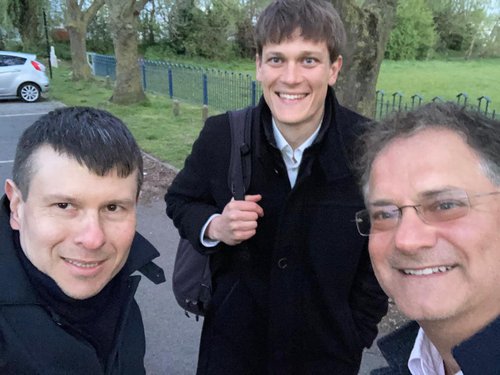Zoltán Molnár co-corresponding author on new sleep regulation paper

The paper is entitled 'A role for the cortex in sleep–wake regulation', DOI number 10.1038/s41593-021-00894-6 and can be found here. The main motivation of the work undertaken in collaboration between laboratories of Vlad Vyazovskiy and Zoltán Molnár, at the Department of Physiology, Anatomy and Genetics and led by Dr Lukas Krone, was to address the role of the cortex in sleep at three distinct levels: the local dynamics of sleep oscillations, global architecture of sleep-wake states and sleep homeostasis.
The study monitored brain activity – from discharge patterns of single neurons to global EEG waves – in laboratory mice, which is one of the most well studied animal species. Although mice have much smaller brains than humans, and they are typically active during the night, there are fundamental similarities with respect to fine brain anatomy and fundamental mechanisms of sleep regulation. In essence, mice need to sleep as much as humans, do, and over many years we learned at least as much, if not more, from them about sleep as than from our own species. One advantage of using laboratory mice is that new revolutionary techniques of neuroscience allow to selectively manipulate activity of defined brain areas or groups of neurons. Subsequently, scientists can study the effects of such manipulations on behaviour, to understand better its neurobiological substrates. This is exactly what was done in this study.
The cortex in mammals is a layered structure, and the research team selectively silenced a subset of neurons in one particular layer, layer 5, which is considered the main output from the cortex, sending projections brain-wide. It is unlikely that the mice noticed the difference, but the researchers did notice that the mice now stayed awake for at least three hours more every single day! To put this in perspective, an average mouse lives approximately 2 years, which means that it gained three full months of wake time over their lifespan. In human terms it would equate about 10 years!
To investigate whether the mice “feel” sleep drive, the team kept them awake for several hours beyond their habitual bedtime by providing novel objects. Normally, mice (and humans!) get tired the longer we stay awake, and this is reflected in deeper, or as we call it “more intense” sleep afterwards. Perhaps not unexpectedly, this is not what the team observed in the mice, who seems to have lost track of time spent awake. When they went to sleep after staying awake extra time, their sleep was not much deeper than it is normally. The research team also wanted to investigate whether the body clock is affected in the cortically-silenced mice. To this end, they measured locomotor activity and, in collaboration with Oxford Sleep and Circadian Neuroscience Institute (SCNi), used a variety of standard protocols to measure the parameters of their daily rhythms, yet these appeared to be completely normal. This is important, as it suggests that the phenotype the team observed is arising from the change in core sleep mechanisms, rather than altered response to the external cues, such as light.
Altogether, this study offers exciting new
perspectives for understanding the neural substrates of sleep-wake control. The
prevailing model is that sleep-wake states are controlled by structures deep in
the brain only. This study now demonstrates that this is not the case, and, contrary to
the predominant view, cortex plays a much greater role than it was previously
appreciated. This study therefore opens new and exciting perspectives into the
“hard question” of the field: why do we sleep? We still do not know the
substrates of the mysterious process that keep track of time spent awake and
asleep, although these findings at least gives clues as to where to look. But perhaps even
more importantly, this work provides important theoretical basis for the
development of novel therapies and sleep modulation technologies, aimed to
improve or enhance sleep when it is disrupted.
Please join us in congratulating the research team on this exciting publication!